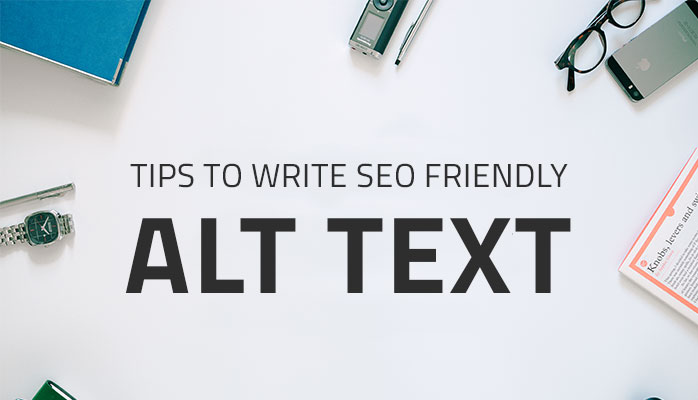SEO-Friendly Alt-Text for Your Images
In the world of hyper-fast bandwidth and global internet connection, it’s easy to overlook the small details. Not everyone is able to experience the internet and all of the content on offer in its full glory.
Some people have slow internet while others have physical impairments. Studies have shown that major outlets such as CNN and Amazon use alt-text for over 90% of their content.
To that end, Google has decided to make alt-text implementation a norm in its SEO rulebook. Alternative text (or alt-text for short) represents the literal description of a multimedia piece of content. Let’s take a look at the reasoning behind this as well as a simple guideline as to how you can use alt-text for your own content.

Importance of alt-text
Alternative text has a multitude of benefits that make it an appropriate addition to any website’s SEO. Multimedia content such as images or graphs often takes long to load even by today’s standards. People without fast bandwidth will often be left behind and disappointed by your inability to provide for their specific needs. Some of the most important factors that alt-text brings include:
- Google can see, read and understand your multimedia
- Better SEO ranking
- More traffic and conversions
- Faster load times and less bandwidth consumption
When it comes to user-specific benefits, alt-text is a robust tool and a worthy investment as well:
- People with sight problems can enjoy your content thanks to alt-text
- People with very poor connections and/or limited bandwidth can experience all of your content
- Mobile users with smaller screens can preview images through alt-text before loading them
- Set your goals and standards
The first part of successful alt-text content optimization is to know what you really want to accomplish. Do you want to make your content faster to load or easier to experience? Do you want to attract a wider audience or simply appease Google’s SEO standards?
Your goals will define the amount of time and resources you will spend on alt-text optimization. Your standards concern the system you will use to implement alt-text. In order to make the most of SEO ranking, your entire website should be alt-text optimized. This means that you should use the same naming system and keywords throughout your site.
- Keyword research
Don’t assume which keywords are popular in your industry. If you offer design services to your clients, “graphic design” might not be specific enough of a keyword. However, “corporate graphic design” is another matter entirely. Reflect on your brand and products (even if you are a blogging website) before choosing the keywords.
You can easily implement a tool such as Google AdWords in order to see which keywords you should use and which to avoid. Tracking popular keywords and changing your alt-text as time goes on is just as important as the technical SEO of your content.
- Direct and precise definitions
Alternative text requires pinpoint accurate information in order to work correctly. Since Google is the first thing that registers alt-text, you need to make sure that your definitions are spot on. For example, if your site features a photo of a puppy wearing a red scarf, what should your alt-text look like?
- “This photo features a puppy with a red scarf which is pretty cute – it’s also day time”
- “Puppy with a red scarf in daytime”
You can easily see the difference between these definitions. The first one focuses on human logic and doesn’t abide by Google’s SEO rules. However, the second one represents an accurate example of how alt-text should be formatted.
It’s also a good idea to pay some attention to translation and localization of alt-text. Many of your readers use localized search engines all around the world. Hiring a writer from a service such as PickWriters can prove highly beneficial for your site’s overall alt-text SEO optimization.
- Short-form alt-text
Alternative text works best when you write it short. Long alt-text rarely works as well as it should. The reason for this is simple – Google’s algorithm isn’t sophisticated enough to read it. Since it can’t be read correctly, it also cannot be ranked accordingly. This is why short alt-texts with relevant keywords and highly popular phrases work the best. Try doing some research into your niche’s trends and see if you can come up with very short sentences that describe your images. For example, how should an image that features your entire staff look like?
- “This is an image of Steve, Josh, Eve, Amanda, Brook and I in front of our office during lunch hour – we like to goof around.”
- “Happy office staff during lunch hour”
It cannot be overstated how important short-form alt-text is. If it makes things easier, you can pretend that you are “talking” to Google while you write alt-text. The process becomes much simpler once you realize that you are addressing the search engine above anyone else.
Even more multimedia SEO
While alt-text is very important, it’s not the only factor on the table. In order to make the most of SEO as a whole, there are several tricks which you can use.
These tips mainly concern multimedia content featured on your site. Using them correctly will not only rank your links higher but increase your load speeds and decrease your bandwidth strain:
- Optimize your images and video by compressing them through editing software. Decreased size doesn’t mean decreased quality (when web is concerned)
- Make sure that your multimedia fits well with the rest of your website’s design. Placement of images and video files in an article can make your formatting much more legible and SEO-friendly.
- Create original content whenever possible – don’t rely on stock photos and video. This content is a great placeholder in emergencies but it doesn’t work well with SEO or your readers.
- Don’t bloat your content with images. There should always be a healthy balance of written content and multimedia. Veering to either side will lower your SEO ranking and make your content less legible.
In conclusion
It’s easy to see the appeal and practical benefits of alt-text. Once you get into the habit of including alt-text, make sure that you are fully committed. Having partial coverage of alt-text won’t do you any favors when SEO is concerned.
Any and all multimedia content should fall under this rule if you want to take full advantage of what alt-text has to offer. Before you know it, it will become second-nature for you to optimize content with alt-text and make sure that it is seen by as many people as possible.
Kristin Savage has graduated from Columbia University where she was majoring in Germanic Languages. Besides English as her mother tongue she also speaks German and Dutch fluently. Currently Kristin is studying Spanish and planning to obtain her PhD in Applied Linguistics since she is interested in how to use her to some extent practical knowledge of language processes in everyday life.


















